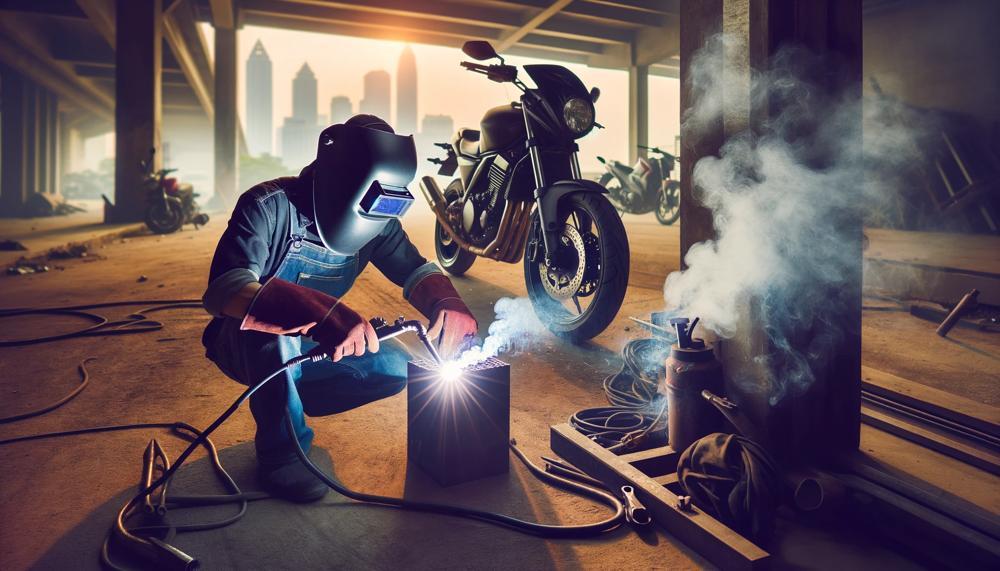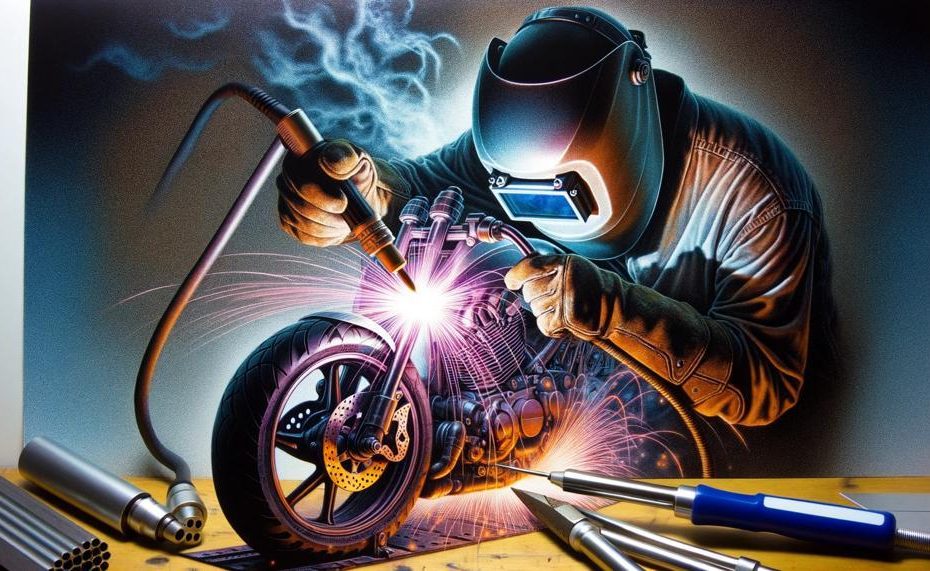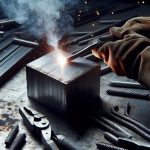For motorcycle lovers, their bike is more than just a means of transportation – it’s a symbol of freedom, adventure, and passion.
But with great rides comes great responsibility, and one of them is proper maintenance. As riders, we understand the importance of keeping our beloved bikes in top shape for safe and enjoyable journeys.
So, what kind of welder do i need for a motorcycle?
A TIG welder is a good choice for welding a motorcycle because it offers better weld control and can be used to weld a variety of metals, including steel, stainless steel, and aluminum. TIG welding is also better for smaller projects and thinner metals because it produces clean and precise welds.
So gear up and let’s explore the best welders for your two-wheeled companion.
Contents
- 1 What Welding Technique Is Best for Motorcycle Frame?
- 2 Can You Stick Weld A Motorcycle Frame?
- 3 What Are the Tools and Things You Need before Motorcycle Frame Welding?
- 4 How Do You Stick Weld a Motorcycle Frame: Step-by-Step Guide
- 5 Motorcycle Frame Welding Common Mistakes and How to Avoid Them?
- 6 Conclusion
What Welding Technique Is Best for Motorcycle Frame?
When it comes to constructing a motorcycle frame, there are several welding techniques that are recommended, such as MIG welding, TIG welding, FCAW, SMAW, laser beam welding, and plasma arc welding. Each of these methods has its own unique set of advantages and limitations, making them suitable for different types of frames and project objectives.
Welding Technique Advantages Limitations
- Gas Metal Arc Welding (MIG) – Versatile and easy to learn – Cost-effective – Strong welds with minimal distortion – Requires external gas supply – Not suitable for thicker materials
- Gas Tungsten Arc Welding (TIG) – Precise and clean welds – Suitable for thinner materials – Can be used on various metals including aluminum – No flux or filler material needed – Requires skill and experience – Slower process compared to MIG welding – More expensive equipment
- Flux-Cored Arc Welding (FCAW) – Suitable for thicker materials – Can be used in outdoor conditions – Offers deeper penetration compared to MIG welding – More spatter compared to MIG welding – May require external gas supply depending on the type of wire used
- Stick Welding (SMAW) – Cost-effective – Produces deep and penetrating welds – No external gas supply needed – Not suitable for thinner materials – Requires proper preparation and selection of electrodes
- Laser Beam Welding – High precision and accuracy – Can be used on various materials – No need for filler material – Expensive equipment – Limited to flat or nearly flat surfaces – Requires extensive safety precautions due to high-intensity laser beam
- Plasma Arc Welding – High-quality welds – Can be used on various materials – No flux or filler material needed – Expensive equipment – Not suitable for thicker materials – Requires a skilled operator
- Atomic Hydrogen Welding – Strong, clean, and precise welds – Suitable for high-strength materials such as titanium – Requires specialized equipment and setup – Requires a skilled operator – Extremely sensitive to contaminants such as moisture and oxygen in the environment
Choosing the best welding technique for your motorcycle frame depends on various factors, including the type of material, thickness, and desired weld strength. For beginners, MIG welding may be a good option due to its versatility and ease of learning.
However, stick welding still has its uses, as many professionals prefer it for its cost-effectiveness and strong penetration on thicker materials.
Can You Stick Weld A Motorcycle Frame?
Yes, indeed. Stick welding, also known as arc welding or shielded metal arc welding (SMAW), is a versatile and cost-effective process for creating robust and long-lasting welds. To successfully repair a motorcycle frame using stick welding, you will require the following equipment:
- A top-quality stick welder: This is the primary tool used in stick welding. It provides the necessary electrical current to create an arc between the electrode and metal surface.
- Appropriate electrodes: These are rods that can be consumed, coated in flux to provide a shield gas, and form the filler metal during the welding process.
- Ground clamp: This connects the welder to the metal surface being welded, completing the electrical circuit.
- Electrode holder: This holds the electrode and allows you to strike and maintain the arc.
- Safety gear: Welding can be hazardous, so it is crucial to have proper safety gear such as gloves, a helmet, and protective clothing.
In addition to having the necessary equipment, it is essential to follow proper techniques when using stick welding to repair a motorcycle frame.
These include thoroughly cleaning the surface of the frame before beginning the welding process, setting appropriate amperage and polarity, adjusting the arc length and electrode angle, and selecting the correct type of electrode for the specific metal being welded. It is also crucial to prioritize safety and have proper equipment when taking on any welding project.
What Are the Tools and Things You Need before Motorcycle Frame Welding?
When preparing to weld a motorcycle frame, it is crucial to gather all the necessary tools and equipment to guarantee a safe and successful weld. These tools and equipment include:
- Welder: A top-quality welder is essential for welding a motorcycle frame. It must have sufficient amperage to handle the thickness of the tubing being welded.
- Electrodes: The correct electrode must be chosen based on the type of metal being welded. Various types of electrodes are available for different types of metals, such as mild steel, stainless steel, or aluminum.
- Protective Gear: Welding can produce intense heat, sparks, and harmful UV rays, so it is crucial to wear appropriate protective gear. This includes a welding mask or helmet, gloves, and protective clothing.
- Workspace: Ample space to maneuver around the frame while welding is vital. Ensure there are no flammable materials nearby and keep a fire extinguisher within reach.
- Cleaning Tools: Before welding, it is critical to clean the surface of the frame from rust, paint, and debris. This can be done using a wire brush or grinder.
- Clamps, Hammers, Chisels, and Files: These tools are necessary for securing pieces in place and shaping them as needed during welding.
- Grinder: A grinder is used to clean metal surfaces before welding and remove excess welds or sharp edges after welding.
- Inspection Tools: Before starting the welding process, it is essential to inspect the frame for any fractures or damages that may require repair before welding.
How Do You Stick Weld a Motorcycle Frame: Step-by-Step Guide
When it comes to stick welding a motorcycle frame, safety should be your top priority. To ensure a successful and secure weld, here are some crucial safety precautions to keep in mind:
- Put on appropriate protective gear, including gloves, safety glasses, and closed-toe shoes. This will safeguard you from sparks and UV radiation.
- Make sure your work area is well-ventilated to avoid inhaling any harmful fumes.
- Keep a fire extinguisher nearby in case of any accidents.
- Have a first aid kit readily available in case of any injuries.
- Always inspect your welding equipment before use to ensure it’s in good working condition.
- Use the correct electrode size and type for the material you are welding.
- Avoid direct contact with the electrode or metal parts of the welder while it’s in operation.
- Keep any flammable materials away from the welding area.
- Never attempt to weld near gasoline or any other flammable liquids.
- Always disconnect the power source when not in use or when changing electrodes.
| Protective Gear | Wear appropriate protective gear, such as gloves, safety glasses, long-sleeved clothing, and closed-toe shoes to shield yourself from sparks and UV radiation. |
| Ventilation | Ensure that your work area is well-ventilated to avoid inhaling any harmful fumes. |
| Fire Safety | Keep a fire extinguisher nearby in case of any accidents. |
| First Aid Kit | Make sure you have a first aid kit readily available in case of any injuries. |
| Equipment Inspection | Prior to using your welding equipment, always inspect it to ensure it’s in proper working condition. |
| Electrode Selection | Choose the appropriate electrode size and type for the material you’re welding. |
| Avoid Contact | Avoid touching the electrode or metal parts of the welder with bare skin while it’s in operation. |
| Flammable Materials | Keep any flammable materials away from the welding area. |
| Avoid Flammable Liquids | Never attempt to weld near gasoline or any other flammable liquids. |
| Power Source | Always disconnect the power source when not in use or when changing electrodes. |
When it comes to stick welding a motorcycle frame, safety should be your top priority. To ensure a successful and secure weld, here are some crucial safety precautions to keep in mind:
Motorcycle Frame Welding Common Mistakes and How to Avoid Them?

When it comes to welding a motorcycle frame, there are common mistakes that can be easily avoided with proper preparation and technique. To ensure a successful welding process without any major issues or risks, it is crucial to prioritize safety and gather all necessary tools and equipment before beginning. This includes a high-quality stick welder, suitable electrodes, a ground clamp, an electrode holder, and safety gear.
Before starting the welding process, it is important to thoroughly clean the surface of the motorcycle frame. This will not only improve performance but also result in tidy joints. Additionally, adjusting the amp setting according to the chosen electrode diameter is crucial to prevent using excessive heat that can damage the frame’s surface. Keeping the heat at a medium level is ideal for maintaining the integrity of the frame.
Lastly, striking the arc accurately is essential to avoid any damage to the frame’s surface. To achieve this, hold the welder firmly with both hands and strike the arc in the correct spot. By following these steps and avoiding common mistakes such as excessive heat usage and inaccurate arc striking, stick welding a motorcycle frame can be done safely and effectively.
| Motorcycle Frame Welding Common Mistakes | How to Avoid Them |
| Excessive Heat Usage | Adjust the amp settings according to the electrode diameter and maintain medium heat levels throughout the welding process. |
| Unnecessary Use of Additional Gases | Utilize the built-in shielding gas of the stick welder and avoid adding any extra gases. |
| Inaccurate Arc Striking | To prevent damaging the frame’s surface, hold the welder firmly with both hands and strike the arc in the correct spot. |
Conclusion
As motorcycle enthusiasts, it’s crucial to keep our bikes in top shape for safe and enjoyable rides. And when it comes to maintenance, welding is a vital component, whether it’s repairing a cracked frame or customizing our beloved machines. However, not all welders are created equal when it comes to motorcycle frames. So how do we choose the right one?
In our exploration of various welding techniques for motorcycle frame construction, we’ve learned about the advantages and limitations of MIG welding, TIG welding, FCAW, SMAW, laser beam welding, plasma arc welding, and atomic hydrogen welding. Each technique offers unique benefits and is suitable for different frame types and project goals.
For beginners, MIG welding may be a good starting point due to its versatility and ease of learning. On the other hand, professionals often prefer stick welding for its cost-effectiveness and strong penetration on thicker materials. But if precision is your top priority and you have the budget for it, advanced techniques like laser beam welding and plasma arc welding may be worth considering.
Of course, having the right tools is just as important as choosing the right technique. For stick welding a motorcycle frame, you’ll need a welder, electrodes, protective gear, workspace essentials like cleaning tools and clamps, as well as hammers and files for finishing touches. And with our step-by-step guide on safely stick welding a motorcycle frame while avoiding common pitfalls like excessive heat usage and inaccurate arc striking, you’ll be well-equipped to take on any project.
In conclusion, selecting the best welder for your motorcycle frame depends on several factors such as material type and desired weld strength. By following proper safety measures and techniques when using stick welding to repair or customize your bike’s frame, you can ensure a successful project without any major issues or risks.





